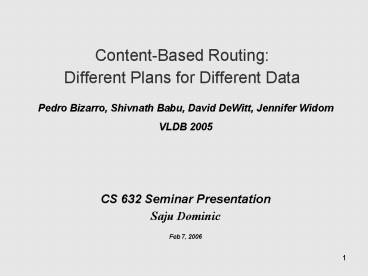Content-Based Routing: Different Plans for Different Data - PowerPoint PPT Presentation
Title:
Content-Based Routing: Different Plans for Different Data
Description:
Content-Based Routing: Different Plans for Different Data Pedro Bizarro, Shivnath Babu, David DeWitt, Jennifer Widom VLDB 2005 CS 632 Seminar Presentation – PowerPoint PPT presentation
Number of Views:90
Avg rating:3.0/5.0
Title: Content-Based Routing: Different Plans for Different Data
1
Content-Based RoutingDifferent Plans for
Different Data
- Pedro Bizarro, Shivnath Babu, David DeWitt,
Jennifer Widom - VLDB 2005
- CS 632 Seminar Presentation
- Saju Dominic
- Feb 7, 2006
2
Introduction
- Different parts of the same data may have
different statistical properties. - Different query plans may be optimal for the
different parts of the data for the same query. - Concurrently run different optimal query plans on
different parts of the data for the same query
3
Overview of CBR
- Eliminates single plan assumption
- Identifies tuple classes
- Uses multiple plans, each customized for a
different tuple class - Adaptive and low overhead algorithm
- CBR applies to any streaming data
- stream systems
- regular DBMS operators using iterators
- and acquisitional systems.
- Implemented in TelegraphCQ as an extension to
Eddies
4
(No Transcript)
5
(No Transcript)
6
(No Transcript)
7
(No Transcript)
8
(No Transcript)
9
(No Transcript)
10
Classifier Attributes
- Goal identify tuple classes
- Each with a different optimal operator ordering
- CBR considers
- Tuple classes distinguished by content, i.e.,
attribute values - Classifier attribute (informal definition)
- Attribute A is classifier attribute for operator
O if the value of A is correlated with
selectivity of O.
11
(No Transcript)
12
(No Transcript)
13
Classifier AttributesDefinition
- An attribute A is a classifier attribute for
operator O, if for any large random sample R of
tuples processed by O, GainRatio(R,A)gt??, for
some threshold ?
14
Content-Learns AlgorithmLearning Routes
Automatically
- Content-Learns consists of two continuous,
concurrent steps - Optimization For each Ol ? O1, ,On find
- that Ol does not have a classifier attribute or
- find the best classifier attribute, Cl, of Ol.
- Routing Route tuples according to the
- selectivities of Ol if Ol does not have a
classifier attribute or - according to the content-specific selectivities
of the pair ltOl, Clgt if Cl is the best classifier
attribute of Ol
15
(No Transcript)
16
(No Transcript)
17
Adaptivity and Overhead
- CBR introduces new routing and learning overheads
- Overheads at odds with adaptivity
- Adaptivity ability to find efficient plan
quickly when data or system characteristics change
18
(No Transcript)
19
(No Transcript)
20
(No Transcript)
21
Experimental ResultsRandom Selectivities
- Attribute attrC correlated with the selectivities
of the operators - Other attributes in stream tuples not correlated
with selectivities - Random selectivities in each operator
22
(No Transcript)
23
(No Transcript)
24
Conclusions
- CBR eliminates single plan assumption
- Explores correlation between tuple content and
operator selectivities - Adaptive learner of correlations with negligible
overhead - Performance improvements over non-CBR routing































